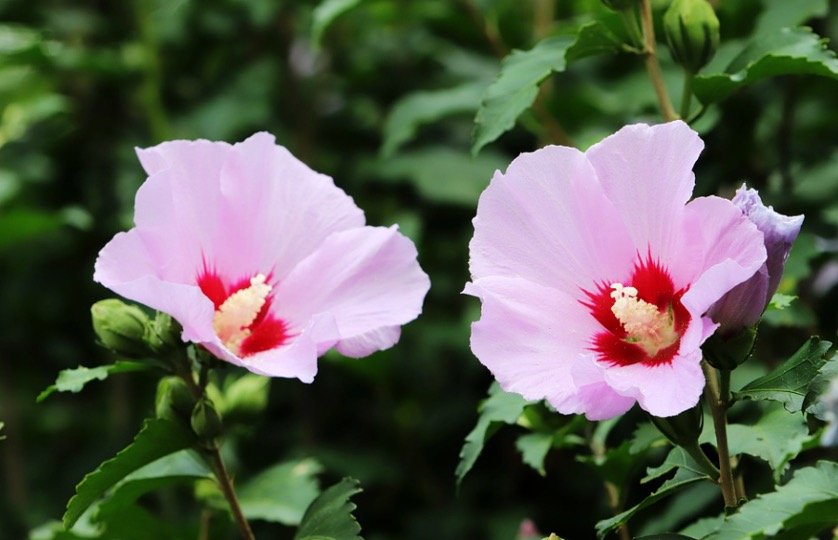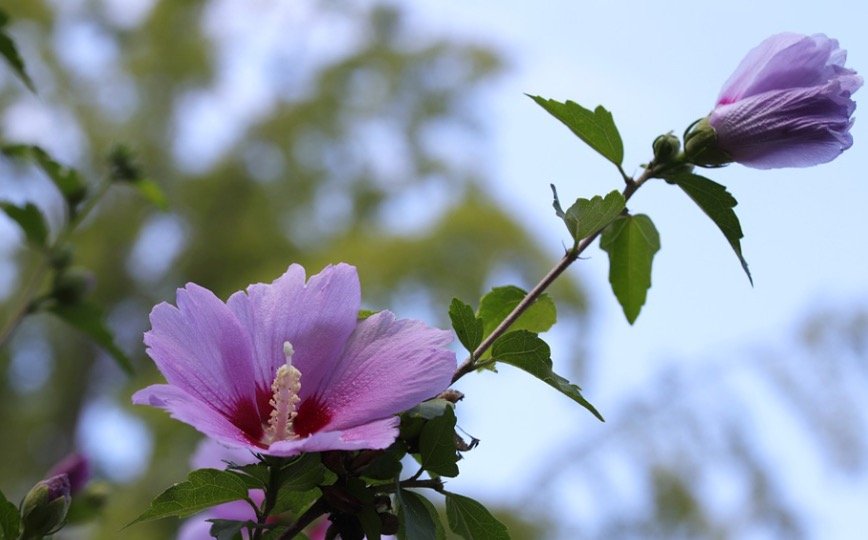Rose of Sharon: Care, Growing Guide, & Facts

Rose of Sharon Plant Description
The Rose of Sharon (Hibiscus syriacus) is a deciduous hibiscus that blooms profusely in the summer and autumn.
The five-petaled, paper-like flowers are available in a variety of hues, including bicolors with a diameter of three inches. The stamens are large, and the throat is frequently black in colour.

Rose of Sharon has medium to dark green leaves and a natural upright vase form. This shrub, however, may be pruned to a single trunk and turned into a tree.
Rose of Sharon may be planted in the spring or fall, and it grows one to two feet each year at a moderate rate. The family of this plant is Malvaceae, and it’s a shrub.
The flowers are usually pink, purple, lavender, red, blue, and white, often with dark throats, and are seen in Asia. They can grow up to 8 to 12 feet tall and 6 to 10 feet wide.
How To Care Rose of Sharon?
This plant can withstand urban environments, including heat, humidity, poor soil, and drought. It’s mostly used as a specimen plant, hedge, or foundation plant.
It rapidly self-seeds, so if you don’t want additional Rose of Sharon in your environment, be prepared to remove seedlings. To get started, young plants will require frequent watering and feeding.
However, established bushes usually don’t require much attention. If the drought lasts for a long time, prepare to water. Pruning should be done on a regular basis to keep the shrub in proper form.
How To Grow Rose of Sharon?
i. Light
Rose of Sharon loves the full sun, which means at least six to eight hours of direct sunlight. It may, however, grow in moderate shade. Too much shade, on the other hand, might reduce blooming and lead to problems like fungal infections.
ii. Soil
This shrub thrives in a variety of soil types, including loamy, sandy, and clay. It needs nutrient-rich, well-draining soil with a pH range of mildly acidic to neutral, though it may tolerate slightly alkaline soil as well.
iii. Water
Rose of Sharon prefers moist soil, though older plants can tolerate some drought.dryness or extreme wetness will kill the fringes. So make sure your shrub isn’t resting on soggy soil and don’t let the soil completely dry up.
iv. Temperature and Humidity
These bushes like the sun, but they can also weather winters with temperatures as low as -20 degrees Fahrenheit. They can even withstand excessive humidity, provided there is adequate air movement. Humidity, on the other hand, might encourage fungus development.
v. Fertilizer
Fertilizer is advised for matured shrubs, although it is not required unless the soil quality is inadequate. In the late winter or early spring, apply a slow-release fertiliser according to the label’s directions.
Spread and stir an inch or two of compost into the soil around the root zone in the spring if you wish to adopt organic growing techniques.
Varieties of Rose of Sharon
Here are some other famous Rose of Sharon cultivars:
1. ‘Blue Chiffon’: From mid-summer to fall, this cultivar produces double blooms with a purple-blue hue. It reaches a height of 8 to 12 feet and a width of 6 to 10 feet.
2. ‘Sugar Tip’ refers to the variegated leaves with a creamy-white border on this variety. It grows 6 to 8 feet tall and 4 to 6 feet wide, with pink double blooms.
3. ‘White Chiffon’: This cultivar has solid white blooms with no contrast in the throat. It reaches a height of 6 to 8 feet and a width of four to six feet.
4. ‘Crimson Heart’: The ruffled blooms of this shrub have white petals with dark red centres. This is a sterile cultivar, so there will be no seedlings to remove, which is great for low-maintenance landscaping.
Rose of Sharon Pruning
Because this shrub grows in a fairly appealing shape, it doesn’t require much trimming. However, you may control its development each year to keep it at the size and form you choose.
Rose of Sharon blooms on new wood, so trim it late in the winter or early in the spring to prevent cutting off any flower buds later in the season.
Pruning back stem tips promotes greater branching and, as a result, more blooms. As soon as you notice any broken or diseased branches, remove them. meaning
How to Propagate Rose of Sharon?
Stem cuttings are the best approach to growing this plant. This is not only a cheap way to grow a new plant, but it also allows you to keep the lineage of a variety whose flowers you particularly enjoy. Mid-summer is the best time to take cuttings.
• Trim a four-to six-inch-long, pencil-wide stem. Cut the leaves from the stem’s lower half.
• Rooting hormone should be dipped into the cut end of the stem.
• In a shallow container filled with soilless potting medium, plant the bottom third to bottom half of the stem. Check for drainage holes in the container.
• To softly wet the growth medium, water it.
• Cover the vessel with a transparent plastic bag.
• Place the container near a warm, indirect light source.
• Once every day, check the growth media to make sure it’s still wet. If necessary, add extra water, but don’t let it become soggy.
• After seven days, discard the plastic bag.
• In one to two months, look for roots. If you feel resistance when pulling on the stem, it has roots. The presence of new leaf growth indicates that the stem has rooted.
• Before placing it in your garden, wait for at least 2 inches of stem development.
How To Grow Rose of Sharon From Seed?
Rose of Sharon self-seeds rapidly in the garden, and you may also sow seeds. In the spring, start seeds inside about 12 weeks before the final expected frost date. Plant each seed approximately half an inch deep in a container filled with soilless potting mix.
Mist the soil lightly and set the container near a bright window in a room with a temperature of 75 to 80 degrees Fahrenheit. Keep the soil wet at all times, and germination should occur in 2 to 4 weeks.
Rose of Sharon in Cold Weather
Rose of Sharon does not usually require any special winter care in its hardiness zone.It must be ideally located in an area that is shielded from strong, chilly, and drying winds. If you live in a colder area of the shrub’s hardiness zone, a layer of mulch around its roots can also assist in protecting it from harsh weather.
Common Pets of Rose of Sharon
The Japanese beetle is the main pest concern for this plant. Because of their large size, Japanese beetles are relatively simpler to manage than many other insect pests. That means you’ll probably notice them before they cause significant damage to your plant.
Picking or shaking them off the plant by hand and dropping them into a container filled with soapy water is the simplest way to destroy them. Because the insect breathes via its skin, a soapy covering essentially suffocates it.
Rose of Sharon Blooming
If the Rose of Sharon is given full light, enough nutrients, and appropriate soil moisture, it will blossom year after year. The magnificent blossoms develop in mid-summer and can last until the end of the season, or even until frost.
The five prominent petals are ruffled somewhat, and the tubular stamen in the middle is noticeable. Bees, butterflies, hummingbirds, and other pollinators are drawn to the blossoms.
It is not essential to deadhead to encourage prolonged flowering. It will, however, hinder the formation of seed pods, so it is suggested if you wish to keep seedlings from sprouting.
Common Problem in Rose of Sharon
In its natural habitat, this shrub is typically hardy. Inadequate circumstances, on the other hand, can lead to a number of frequent problems.
Leaves Turning Yellow: Once your shrub’s leaves turn yellow, it’s usually due to overwatering. Ensure that your shrub is placed in soil with good drainage and that it is never soggy. If your shrub is in a poorly drained area, it may be essential to relocate it.
Not Blooming: A shrub that isn’t flowering well or at all might be caused by a number of factors. It’s likely that you trimmed too late in the spring and accidentally eliminated bloom buds. Drought can also reduce flowering, so give your shrub some extra water during very hot and dry periods.
In addition, phosphorus-deficient soil might result in decreased flower output and smaller flowers. Perform a soil test to check if you have any shortages, and then add fertiliser as recommended.





